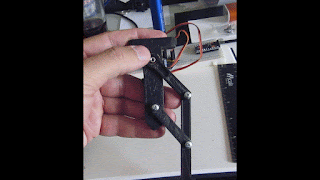Currently, I am testing and making improvements to the design of the Leg Modules. The video below shows the progress of the second iteration of the leg design. The biggest improvement was a re-worked Cam which pulls the leg up bending at the knee and compressing the spring (this completes a Serial Elastic Actuator of sorts)
The new cam is larger than the previous version. the increased size will create more pull on the leg with the same amount of angular change. Thus it will pull the cable farther and faster.
I was also able to correct a design oversight regarding the positioning of the Cam relative to the guide post on the leg. by adding a mounting spacer, the cam is in the correct position. One of the best parts of using a CAD is that by manipulating all of the parts in the CAD system, it is possible to identify the issues and (hopefully) resolve them in design stages - prior to printing.
 |
| Mojo2 - OpenSCAD model |
OpenSCAD Leg Model and Actual


















